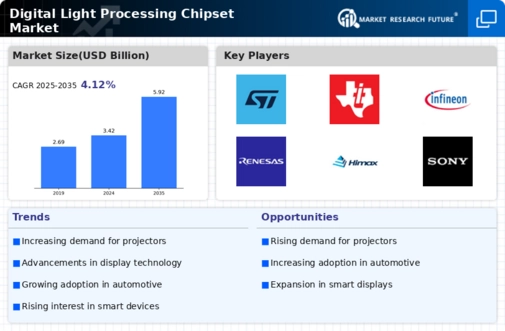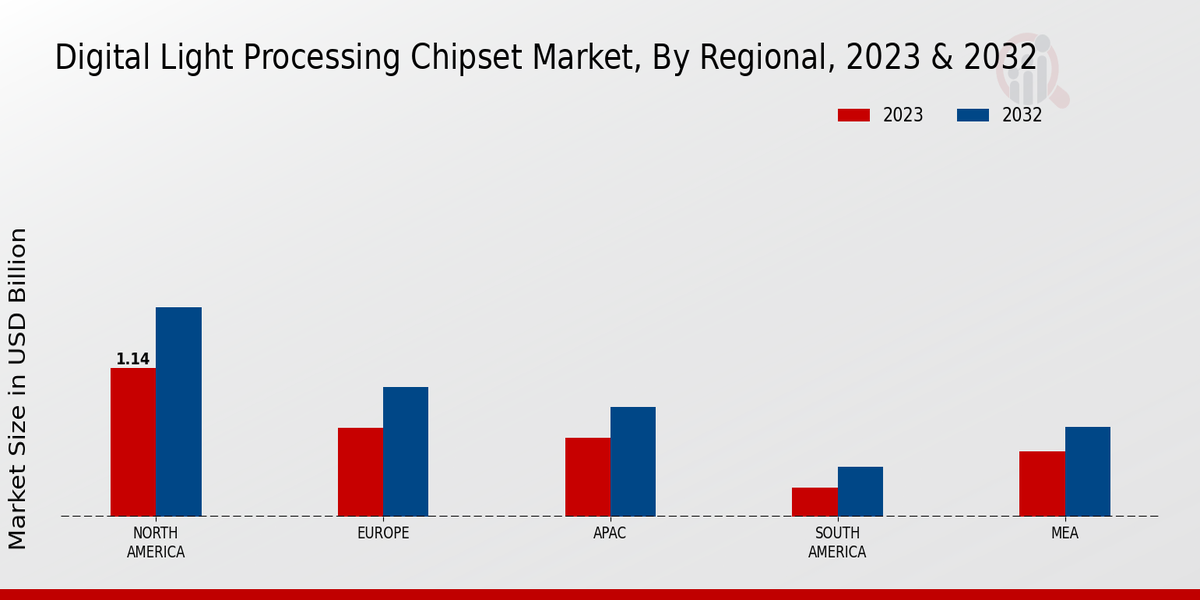Market Growth Projections
The Global Digital Light Processing Chipset Market Industry is projected to experience substantial growth over the next decade. The market is expected to reach 3.42 USD Billion in 2024 and is anticipated to grow at a CAGR of 5.12% from 2025 to 2035, potentially reaching 5.92 USD Billion by 2035. This growth trajectory reflects the increasing adoption of DLP technology across various sectors, including entertainment, education, and corporate environments. The demand for high-quality displays and advancements in projection technology are likely to drive this expansion, indicating a robust future for the DLP chipset market.
Growth in Education Sector
The education sector's growth is a notable driver for the Global Digital Light Processing Chipset Market Industry. With the increasing integration of technology in classrooms, educational institutions are adopting DLP projectors for their ability to deliver clear and engaging presentations. The shift towards hybrid and remote learning environments has further accelerated the demand for reliable and high-quality projection solutions. Schools and universities are investing in DLP technology to facilitate interactive learning experiences, which is likely to contribute to the market's expansion. As educational institutions prioritize technology-enhanced learning, the DLP chipset market is poised for sustained growth.
Technological Advancements
The Global Digital Light Processing Chipset Market Industry is experiencing rapid technological advancements that enhance the performance and capabilities of DLP chipsets. Innovations in micro-mirror technology and improved light source efficiency are driving the development of high-resolution displays and projectors. For instance, the integration of LED and laser light sources is enabling brighter and more vibrant images, which is appealing to consumers and businesses alike. As a result, the market is projected to reach 3.42 USD Billion in 2024, reflecting the growing demand for advanced display solutions across various sectors.
Emerging Markets and Urbanization
Emerging markets and urbanization are pivotal factors propelling the Global Digital Light Processing Chipset Market Industry. As urban populations grow, there is an increasing demand for advanced display technologies in various applications, including advertising, education, and entertainment. Countries in Asia-Pacific and Latin America are witnessing rapid urbanization, leading to higher investments in infrastructure and technology. This trend is likely to boost the adoption of DLP chipsets in new projects, such as smart cities and modern entertainment venues. The market's growth in these regions indicates a shift towards more sophisticated display solutions, aligning with global technological advancements.
Expansion of the Entertainment Industry
The expansion of the global entertainment industry significantly influences the Global Digital Light Processing Chipset Market Industry. As the demand for high-definition content increases, the need for advanced projection technologies becomes more pronounced. DLP chipsets are widely utilized in cinemas, theme parks, and live events, where high-quality visuals are essential for audience engagement. The proliferation of streaming services and the production of blockbuster films further drive the adoption of DLP technology. This trend suggests a robust growth trajectory for the market, as entertainment venues invest in state-of-the-art projection systems to enhance viewer experiences.
Rising Demand for High-Quality Displays
The demand for high-quality displays in sectors such as entertainment, education, and corporate environments is a key driver for the Global Digital Light Processing Chipset Market Industry. With the increasing adoption of DLP technology in projectors and televisions, consumers are seeking superior image quality and enhanced viewing experiences. This trend is evident in the growing popularity of home theater systems and large-scale projection systems in commercial settings. The market is expected to grow at a CAGR of 5.12% from 2025 to 2035, potentially reaching 5.92 USD Billion by 2035, driven by the need for high-resolution and immersive display solutions.























